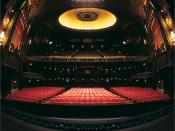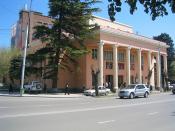After the fall of the Roman Empire during the fifth and sixth centuries, organized dramatic was nowhere to be found for several centuries. Suppressed by the Christian Church, the corrupt theatre that typified Roman Drama was no more. The only theatrical tradition to survive the death of the Roman theatre was that of the wandering actors or mimes.
Having been removed from classical influences for about five centuries, the drama of Medieval Europe developed from ritualistic beginnings. "Although the church had been the obdurate enemy of the decadent classic stage, it inevitably promoted a theatre of its own" (Gassner, 186). A new form of Drama developed out of the ritual of the medieval church's liturgy. The Processional Chant before the mass, or the Introit Psalm was acted out by the priests. Soon scriptural narrative was added to Easter services, and two or more priests would sing the dialog along with the choir.
This became known as the trope . Services were all held in Latin, and the Priests began to act out the chants to help illiterate and uneducated worshipers to understand the stories better(Stauffer, 89).
Simple pantomimes appeared in the church to represent the Nativity and Christmas , and the Passion story and Resurrection. " In time Moreover, Biblical themes were treated by the priesthood at greater length, and the simple dialogued song was succeeded by a variety of liturgical one-act plays in Latin, frequently coalesced as cycles" ( Gassner,186). Finally these plays were translated into the common language of the people, which made them far more accessible and helped the biblical stories to flourish in the imagination of the uneducated peoples who flocked to the churches. " With the change in language the plays could serve to make Christian lore more imaginatively real for illiterate audiences who knew...


